From pour to package to recycling, C3 forges ahead, making innovative machines for packaging, lamination and automation.
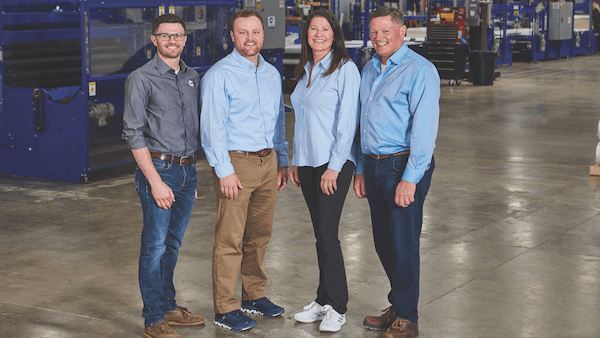
Having just celebrated its 30th year in business in March, C3 Corp. aims to build on its legacy of success by focusing on one key goal: process improvement.
The manufacturer of packaging, lamination and automation equipment constantly examines operations to identify new ways to improve production.
As mattress designs evolve and manufacturing systems change, C3’s engineers also scan the horizon for the latest developments to anticipate where the sleep business is heading next so that the company’s machines keep pace with emerging needs.
“This mentality impacts our entire business,” says Joe Van De Hey, CEO, founder and owner of the Appleton, Wisconsin-based company. “We’re never satisfied with the status quo. Instead, we’re always looking for new solutions to meet our customers’ biggest challenges.”
This year, much of the company’s energies are directed toward recycling and sustainability. Recognizing there are valuable materials that go to waste on plant floors and in trash bins and landfills, C3 is introducing several new machines in 2024 designed to help mattress producers collect scrap materials thrown away after production.
Recently, at a customer’s request, C3 developed its first shredding and baling machines. This equipment enables a bed producer to shred and bale leftover foam and fabric materials generated during manufacturing for easy recycling.
“The ability to recycle is becoming more and more important to manufacturers,” Van De Hey says. Not only is cutting the amount of waste generated during mattress production the right thing to do for the environment, he adds, but it’s also the smart economical choice, since these discarded materials have a financial value. If processed wisely, they can be reused in new, innovative ways.
Going forward, C3 is working on other equipment that would enable the materials within used mattresses to be more easily identified and separated.
Sustainable Solutions: C3 Helps Mattress Manufacturers Reduce Waste
This thinking isn’t new to C3. In 2021, the company introduced one of the first paper-wrap solutions for a compression packaging machine that gives boxed bed manufacturers an alternative to plastic. The approach still requires some plastic, but it reduces the amount of stretch wrap to encase a typical boxed bed by as much as 33%.
The patent-pending paper-wrap technology costs a bit more, Van De Hey says. But for certain customers, particularly those targeting eco-conscious consumers, the extra cost is more than justified.
“A consumer who unboxes a bed wrapped in paper is likely to have a more positive reaction to that brand,” Van De Hey says. In addition to elevating the brand’s sustainability efforts, the paper wrapper also can lead to enhanced consumer satisfaction, since it can be easily recycled or reused. And unlike plastic wrap, the paper will degrade, even if it ends up in
a landfill.
“These consumers can sleep easy knowing that the bed they bought was packaged in an environmentally friendly material,” Van De Hey says.
He adds that by incorporating C3’s patent-pending Paper Roll Cage technology into their production, mattress makers can run paper or stretch film on the same machine for greater flexibility.
Innovation in Boxed Bed Production: Eco-Friendly Packaging with C3
In recent years, C3 has experienced strong growth in the packaging segment of its business. The trend toward selling and shipping beds directly to consumers in boxes took off about 10 years ago, fueling demand for machines capable of compressing, sealing, folding, rolling and bagging mattresses into smaller and smaller bundles.
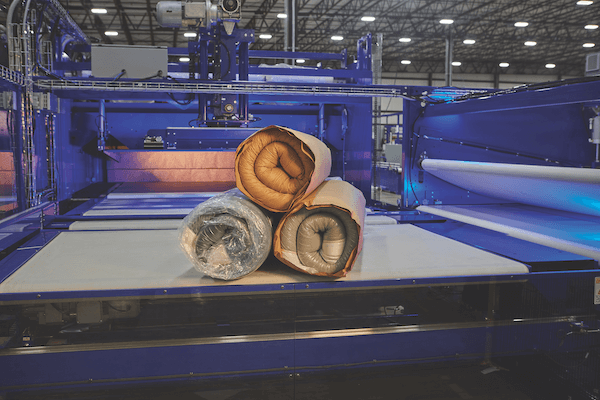

Today, C3 offers a range of compression packaging machines for foam, latex and coil products, from foam blocks and toppers to mattresses and pillows. Its product line enables customers to find the right compression combination for each bed’s construction, Van De Hey says. That’s critical for a packaged mattress to deliver the performance that’s intended once it’s removed and set up in a consumer’s home.
“Everybody wants to get the bundle smaller and smaller,” Van De Hey says. “But just because you have the capability to smash a bed with 200 tons of pressure doesn’t mean you should do it. You’ll get the bed into a box, but you’d never want to sleep on it. The trick is knowing the correct amount of pressure an individual mattress can handle without compromising its quality.”
C3 works with customers to calculate ideal packaging options for their products, “then helps them select the best machine for the job,” he says.
Options — such as the trifold add-on for C3’s CF1396 compression machine, which folds compressed mattresses in thirds rather than in halves — deliver benefits in other areas of the business that cut costs and improve efficiencies.
For example, the trifold reduces the length of a typical boxed bed package by 16 inches, resulting in a 16-by-30-inch packaging size. “That smaller size allows for a greater pallet density, which means better storage capabilities with racking and increased load utilization on trucks,” Van De Hey says.
With proper cubing, C3’s partners have been able to fit more than 500 mattresses in one truckload, he adds, reducing their carbon footprint by 30%.
C3: Your Partner in Building a Better Boxed Bed Business
In addition to compression equipment, C3 offers a range of water-borne and hot-melt lamination machines. Once known mostly for roll-coat applications of water-based adhesives, C3 now enables its existing machinery, such as the LCN1250 machine, to apply hot melt using a bridge add-on. The bridge also can be used as a standalone laminator when combined with a hopper and a conveyor.
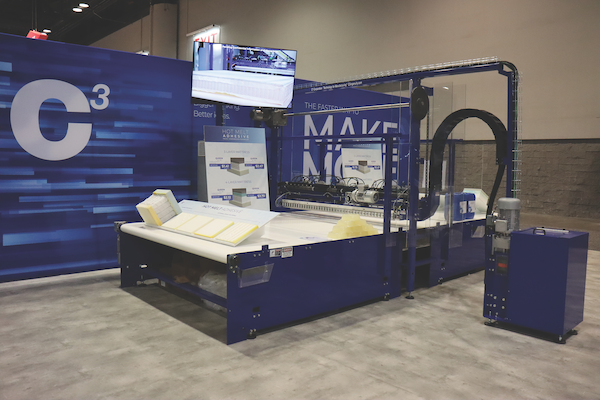
at any weight and speed operators want.
Features include C3’s patent-pending comb-tip technology, which allows for tighter control of each glue application. “This hot-melt technology is challenging the market to think differently about how we can use less glue for a bond that is equally as strong,” Van De Hey says.
The more accurate the tolerances on a roll-coat or hot-melt application, the less material is needed. “Putting on too much glue could add up to a dollar or so wasted on every layer of the mattress you put down, or $4 to $5 for an entire mattress,” he adds. “Multiply that by the hundreds of mattresses that are running down the line each day, and that extra expense adds up fast.”
In addition to saving money, using less glue also supports sustainability by reducing materials. More efficient adhesive application during mattress assembly can also make disassembly and recycling easier when a bed is discarded because excessive glue can pose significant challenges to recyclers.
Each of C3’s lamination systems is designed for different levels of automation, enabling bed producers to select the right match for their workforce. The hot-melt bridge unit, for example, requires only two people to place the layers on the belt and glue them together. This entry-level system eliminates issues with hand spraying — all at a friendly
price point.
To help bedding producers get a better handle on material usage and simplify their supply chain, C3 recently launched a Partnership Program. It offers guaranteed performance, competitive prices and rapid delivery times for various films, paper and adhesives. Clients can mix and match supplies into a single truckload, with delivery intervals timed to match the needs of individual manufacturing lines.
The program also gives customers a percentage credit on purchases. These credits may be redeemed toward the purchase of spare parts, one-on-one training for machine operators, installation costs, machine upgrades, and remote and onsite support.
C3 Partnership Program: Data-Driven Insights for Optimized Boxed Bed Production
As another benefit of the Partnership Program, C3’s service team is more closely integrated into customers’ production to help identify problems before they arise. The relationship also involves systematic collection and analysis of data related to material usage.
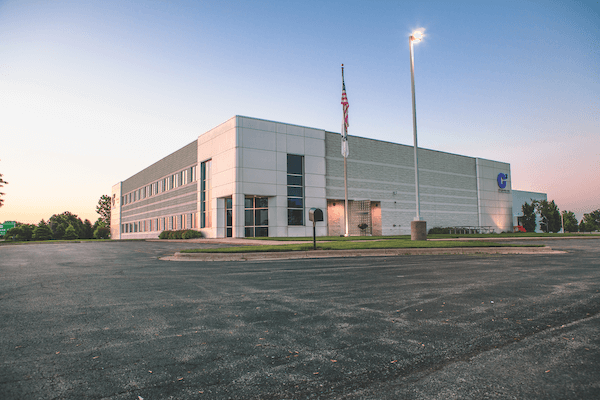
“Many clients, particularly smaller manufacturers, have an issue with managing the control points of their production,” Van De Hey says. “The machine could be on a slightly wrong setting, causing you to use 20% more film than is needed. With our Partnership Program, we can keep an eye on those consumables and, if they’re suddenly trending up, help customers get a better handle on why that’s happening.”
The Partnership Program also can help clients focus on quality. “A producer might switch to a cheaper film to bag their beds that saves them money up front but results in beds being damaged during shipping because the package seals won’t hold,” he says. “That damage could cost a lot more than the savings from the cheaper film. Our goal is to help our customers understand the full picture and to teach them how the machines and consumables were designed to work together.”
Installed in 2019, C3’s enterprise resource planning system provides a new level of capacity when it comes to data management. “We consistently explore innovative uses of our ERP system across all our operations,” Van De Hey says, “leading to the discovery of novel ways to assist our customers.”
Perhaps C3’s website sums it up best: “We are a group of inventive minds who imagine better ways to design and engineer. … First, we imagine it, then we engineer and build it. Lastly, we make sure our customers are getting the most out of it.”
From Idea to Implementation: C3’s Innovation Center for Mattress Manufacturing
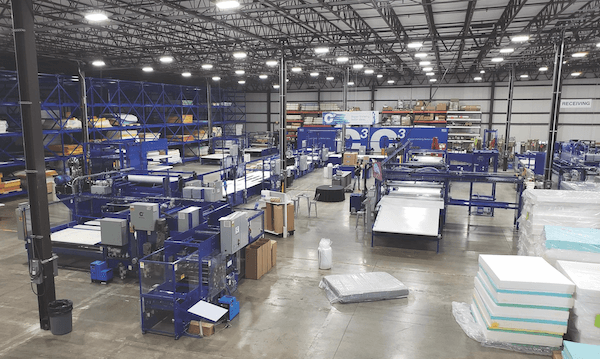
In addition to supplying machinery, C3 is increasingly being called upon to provide answers and advice. “In the past, bedding manufacturers typically had a lot of internal process engineers who would make recommendations to management on how to incorporate new machinery into production,” Van De Hey says.
“Due to employment challenges, including an aging workforce, many companies don’t currently have access to this internal process knowledge, and they come to us for recommendations on how best to build their beds.”
Customer needs vary from single machines to fully integrated lines. “All of our machines are built so producers can easily upgrade and add machinery as their manufacturing scales,” Van De Hey says. “A producer can start small and add more machines as their business grows.”
To support customers, C3 works to attract skilled talent at every level, from salespeople and engineers to installers and service techs. “They all need to be very good at what they do so they can deliver the best solution to the customer’s problem,” he says.
In addition to careful hiring, training also receives a lot of attention at C3.
“We are trying to build expertise within each of our three value streams so that if a customer has a problem, we can get them the answers they need to get back up and running with minimal disruption,” Van De Hey says. “Our customer service starts with good product design — meaning, we try to keep our machines as simple as possible — backed up by having the right people in place who understand all the processes involved in their business area and how to quickly troubleshoot any problems.”
As part of this culture of continual learning, C3 sends electrical and mechanical specialists to customers’ plants during installation. This experience gives the technicians valuable insights into how equipment is used outside of a test environment and sometimes sparks ideas for improvements in plant layout or machine design.
The approach also leads to more job satisfaction for C3’s staff since their involvement extends beyond the plant floor to include direct experience with customers in the field.
“We have a very motivated group,” Van De Hey says. “We’re
a young company, with an average age around 38, and our culture is built on teamwork, open communication and a spirit of innovation.”
With its headquarters in the dairy farmlands of rural Wisconsin, C3 attracts new talent by attending career fairs and other events at local community colleges and universities. “We like to identify young, bright people who we can train,” he says, “then provide them with opportunities to grow and develop their expertise.”
What I love about the sleep business is that there are lots of small family-type companies that were launched by entrepreneurs with a dream.
Finding skilled employees is a challenge for the entire manufacturing sector. “The workforces at most bedding plants have flipped over several times in the past five years,” Van De Hey says. “And each time someone leaves, their knowledge and skills go out the door, too. It takes a lot of time and money to replace those workers.”
To help producers fill this gap, C3 is developing new ways to reduce the manpower needed to build and transport beds, including more use of robotics. One project involves creating a new robot “porter” capable of loading finished beds onto trucks.
“We want to minimize the human handling of mattresses during each stage of production since it’s a basic task that results in a lot of ergonomic issues,” Van De Hey says. “Our customers are demanding cost-cutting suggestions to become more efficient and effective in their production processes. Their mantra is ‘less is more’ — less materials, less labor and less cost.”
C3 has a large space in its second facility on Marshall Road in Appleton dedicated to research and development. The area includes a full production line, where customers can test their own ideas together with C3’s engineers.
“Bedding manufacturers are looking for opportunities to differentiate themselves in the market, and our test line gives them a place to try new ideas,” Van De Hey says. “They are challenging every aspect of building a mattress in search of creating a unique value proposition for their consumers.”
For more C3, read our exclusive interview, BedTimes Interview: Joe Van De Hey, CEO and Founder, C3 Corporation.




